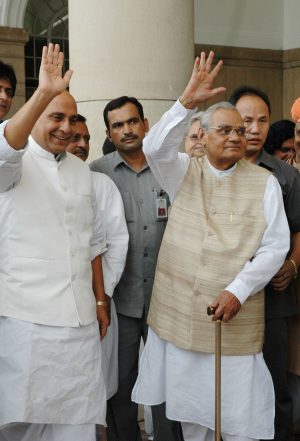In an important speech to India’s parliament earlier today, Defense Minister Rajnath Singh termed the ongoing India-China crisis in eastern Ladakh a “big challenge,” laying the blame for it squarely on China. Speaking less than two weeks after his September 4 meeting with Chinese Defense Minister General Wei Fenghe and five days after the Indian and Chinese foreign ministers met — both meetings having taken place in Moscow — Singh clearly refuted a key Chinese proposition throughout the ongoing crisis in eastern Ladakh: that bilateral relations between the two countries can be delinked from the vexing, and increasingly violent, border dispute between the two.
Singh was speaking on the second day of the monsoon session of the parliament at a time when the opposition Congress Party has repeatedly questioned the Narendra Modi government’s handling of the crisis. In the past, the Modi government has been accused of soft-pedaling the issue. Modi’s statement at an all-party meeting on June 19, four days after the violent India-China clashes at the Galwan Valley (one of the flashpoints in eastern Ladakh), was widely read by many as a sign that the government was hesitant on taking China head on or worse, as capitulation.
Singh’s statement today showed no such signs of evasiveness. Recounting the chronology of events over the past four months, he accused China of disregarding key agreements that had governed conduct of the Indian Army and the People’s Liberation Army (PLA) along the undefined India-China Line of Actual Control (LAC), including through heavy PLA deployments both along the LAC and in the rear. Singh blamed the repeated faceoffs between the two militaries in eastern Ladakh over the past few months on Chinese aggressive behavior, but also spoke of counter-deployments by the Indian Army.
While refusing to discuss ongoing operational issues due to their sensitivity, Singh reiterated that while India was committed to a peaceful resolution of the crisis, the armed forces were prepared for all eventualities, code for refusing to take the military option off the table. Notably, he stated that the government of India remained committed to infrastructure development along the LAC, which many have suggested as the proximate cause for the ongoing crisis.
Three things have become clear following Singh’s blunt speech today.
First, the India-China crisis shows no signs of abating after multiple rounds of talks, including between ministers of both countries. But interestingly, today’s speech also gave no indication that India was willing to call it a day by claiming that diplomacy was working in resolving the crisis — something some in India and abroad suggested New Delhi would do in face of the possibility of exercising force to resolve the crisis.
Second, Singh seemed to put the onus on China when it came to the road ahead. While mentioning talks at various levels, his stance does not indicate India and China “will meet each other halfway,” as Chinese Foreign Minister Wang Yi had suggested last week. In fact in the past, Singh has refused to “guarantee” the possibility that the India-China military commanders’ talks would succeed. His colleague, External Affairs Minister S. Jaishankar, had recently claimed that diplomacy “holds the key” in resolving the crisis, albeit before his meeting with Wang that failed to generate a breakthrough and, instead, added an impression of caving in.
Third, by repeatedly exhorting the parliament – and therefore, the Indian public – to stand by India’s troops while calling China out, the Modi government runs the risk of losing face in front of its domestic audience if, for some reason, it chooses to back down now. At the same time, India’s military options remain limited, its peak-grabbing operations in the southern bank of the Pangong Lake and Rechin La around the weekend of August 30 not having paid dividends. (In his speech today, Singh described those operations — without describing them as such — as a reaction to “provocative [Chinese] military actions.”) Meanwhile, well-connected observers fear the possibility of Chinese counterthrust in reaction to these and other recent moves by the Indian Army, including along the LAC in Uttarakhand, Sikkim, and Arunachal Pradesh – areas that have been relatively calm so far.

































